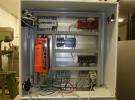Dear,
I'm a bit struggling to read the A (+ and -) and B (+ and -) of a differential quadrature encoder (with a Labjack T7 Pro).
I looked at the explanation on the website which uses DIO2 and DIO3, but I think I need 4 digital lines and need to configure them differential. How is it done? For analog signals, you can choose in Kipling if the negative side is either ground or another analog input. Is this also possible for digital lines?
Also, does someone know what DIO0_EF_ENABLE does? Does it enables all FIO0 to FIO7 and EIO0 to EIO7 lines? Or just a number of them?
I notice there is only DIO0_EF_enable through DIO4_EF_enable?
Is there a python example of reading an differential encoder (X4,1024 PPR)?
Thanks in advance,
Ronny


.png%3Fitok=PHGBxf6M)


.jpg%3Fitok=B1YcuDFK)
.png%3Fitok=Ybt-OlgU)
Digital lines can not be configured as differential. Depending on the encoder you are using you might be able to connect the negative lines to ground. Try with a resistor in series if you are unsure. If your encoder will not tolerate the negative lines being connected to ground then you will need a differential to single-ended buffer.
DIO0_EF_ENABLE turns on the DIO_EF on DIO0 (FIO0). DIO3_EF_ENABLE turns on the DIO_EF on DIO3 (FIO3).
"I notice there is only DIO0_EF_enable through DIO4_EF_enable?"
Kipling only shows a few registers, but if you look at the modbus map you will see the register defined as DIO#(0:22)_EF_READ_A. So DIO#_EF_ENABLE exists for DIO0-22.
There are no examples for a differential encoder because the differential part has to be handled in hardware.